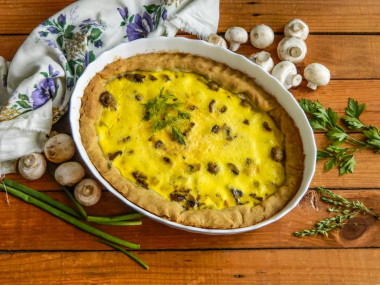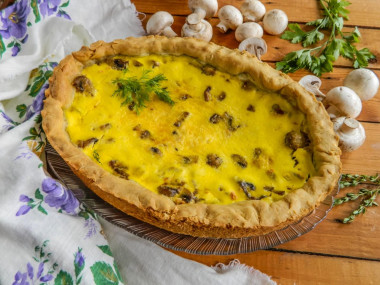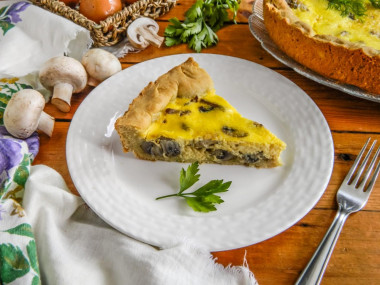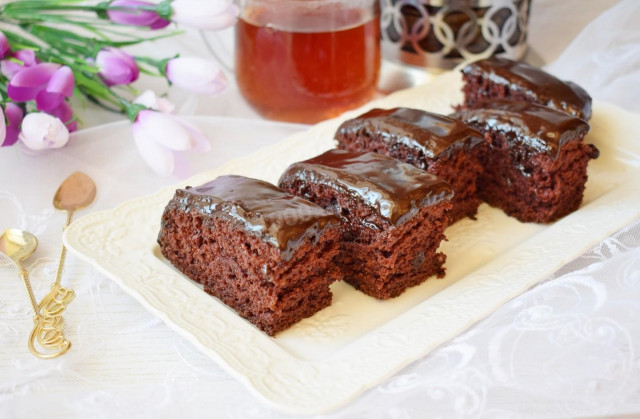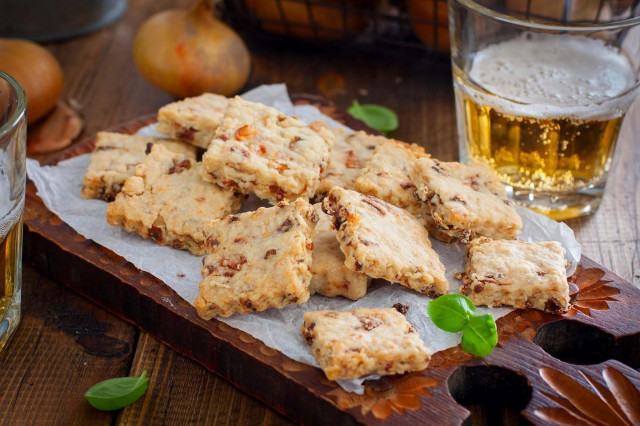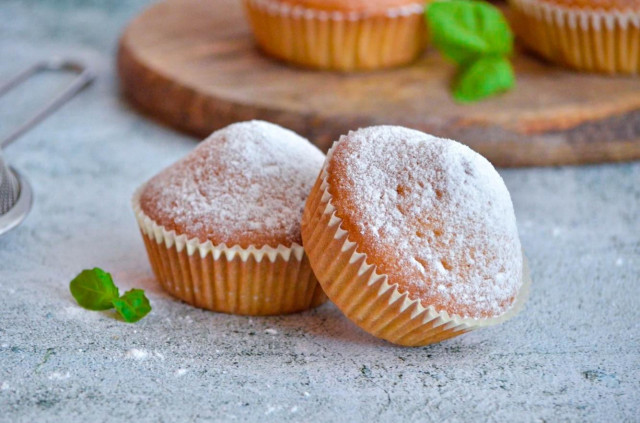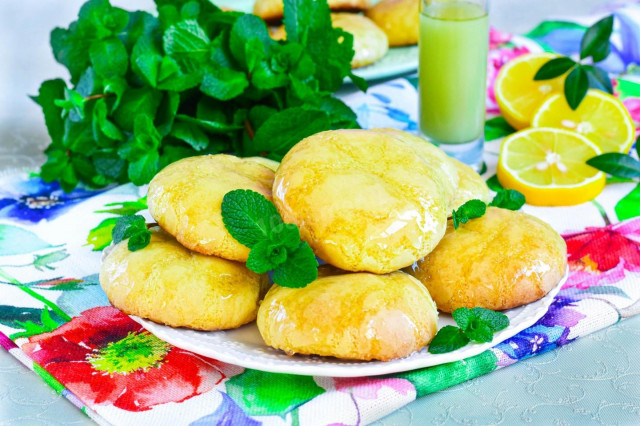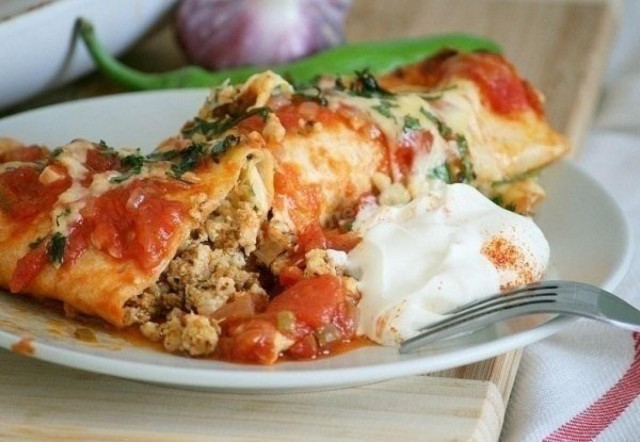Composition / ingredients
Step-by-step cooking
Step 1:
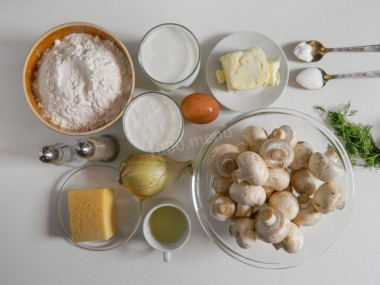
How to make a filling pie with mushrooms? Take the flour of the highest grade, eggs - C1 or C0. Instead of kefir, you can have sour milk or any other fermented milk drink. Kefir and eggs 1-1.5 hours before cooking, remove from the refrigerator. For a more successful test, the products should be at room temperature. Cream can be replaced with low-fat sour cream (no higher than 15%). Instead of champignons, take any mushrooms. Just keep in mind that some of them need to be boiled beforehand.
Step 2:
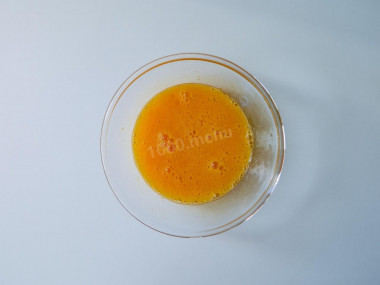
Start by making the dough. Take a deep bowl in which it will be convenient to beat the egg and mix the liquid ingredients. Wash the egg with soap, dry it with a towel or napkin. Whisk it with sugar and salt. It is not necessary to beat until the foam appears. Adding salt improves the taste and simplifies the whipping process.
Step 3:
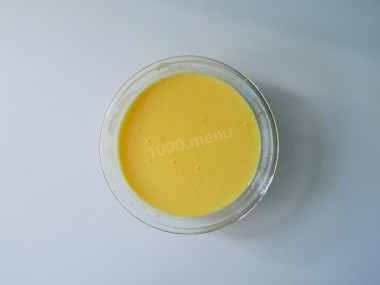
Add kefir and mix. Melt the butter and cool to room temperature. When it cools down, pour it into the egg-kefir mixture. Mix well.
Step 4:
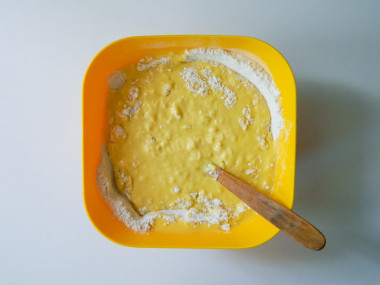
Take a deep bowl with a rounded bottom, in which it is convenient to mix dry and liquid ingredients and knead the dough. Mix half of the amount of flour required by the recipe with soda using a whisk so that the soda spreads over the flour and the dough rises evenly during baking. Sift the flour so that it is saturated with oxygen and the dough is fluffy. Make a recess in the flour and pour the liquid component into it. Start kneading the dough with a spoon or spatula.
Step 5:
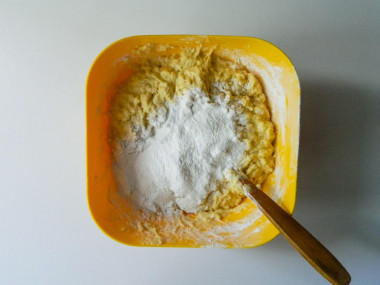
When the flour in the bowl runs out, add the remaining in small portions until you achieve the desired consistency.
Step 6:
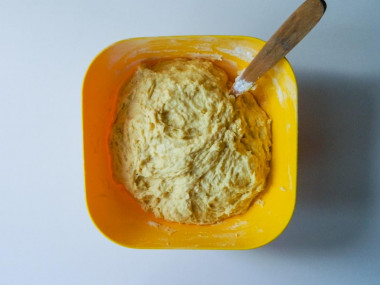
When it becomes difficult to knead with a spoon, start doing it with your hands.
Step 7:
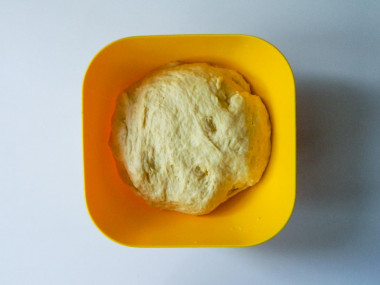
Knead the dough thoroughly. It should be very soft and tender. Cover the dough with cling film or a towel so that it does not chafe and put it in a cool place or refrigerator for 15-20 minutes.
Step 8:
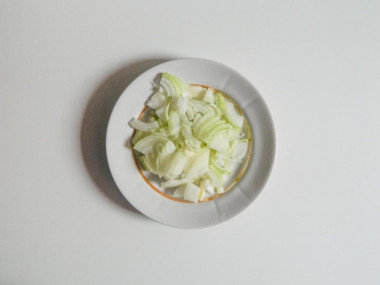
While the dough is infused, prepare the filling. Peel the onion, rinse and cut into thin half rings. So it will quickly get ready and keep its shape.
Step 9:
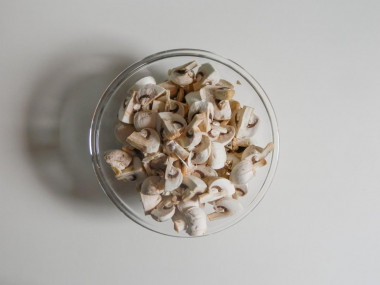
Peel, rinse and chop the champignons coarsely. I had small champignons, I cut them along the leg into 4 parts. This way the taste and shape of mushrooms will be preserved better.
Step 10:
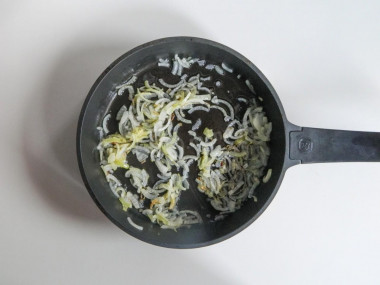
Heat a frying pan with vegetable oil. Fry the onion, stirring occasionally, until golden brown.
Step 11:
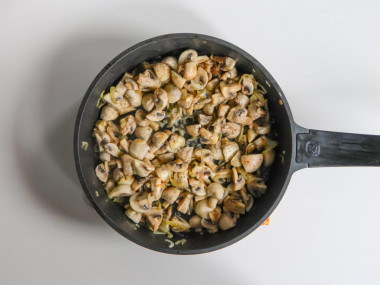
Add the mushrooms to the onion and fry until all the liquid from the mushrooms evaporates. Add salt and pepper to taste. Cool it down.
Step 12:
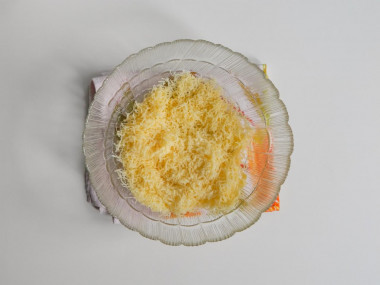
To make the filling homogeneous, grate the cheese finely.
Step 13:
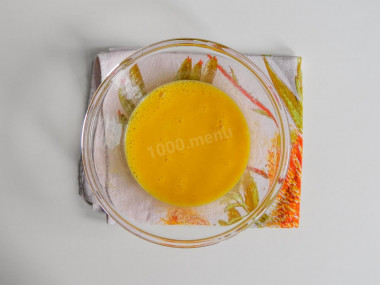
Beat the eggs with a whisk or fork.
Step 14:
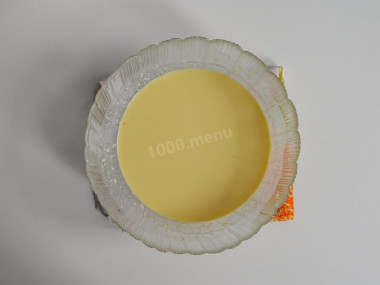
Add the eggs and cream to the grated cheese and mix thoroughly until smooth.
Step 15:
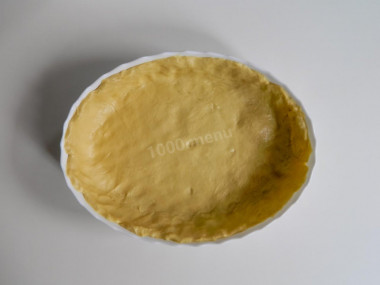
Roll out the dough into a layer according to the shape of the container in which you will bake the pie, of such a size that it covers the bottom and sides. I have an oval shape of 30x25 cm. With your hands, gently spread the dough over the bottom and walls of the mold. The mold can not be lubricated, since the dough contains a sufficient amount of oil.
Step 16:
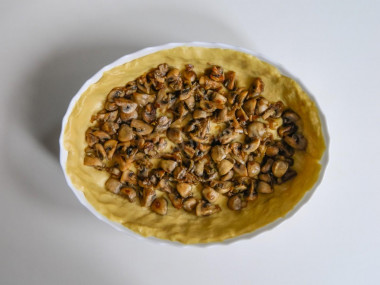
Put the filling on the dough, spread evenly.
Step 17:
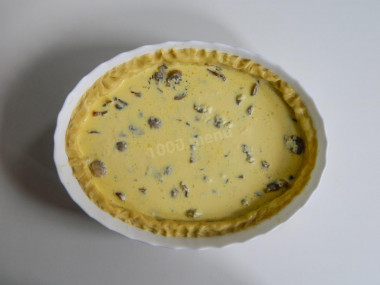
Mix the filling and pour it over the mushrooms. Level the edges of the dough. Bake the pie on the middle shelf of a preheated 180 degree oven for 30-35 minutes. The cooking time depends on the capabilities of the oven. Therefore, check readiness by appearance. The edges of the dough should be evenly browned. To prevent the filling from falling off, leave the finished cake in the oven for another 5 minutes after switching off. Then cool it to a warm state, decorate with herbs and help yourself.
Instead of fresh, you can take frozen or dried mushrooms (dried ones will need 5-6 times less than fresh ones). Frozen mushrooms can be defrosted in any convenient way (for example, in the microwave in the appropriate mode - see the instructions for your technique) and drain the liquid. Or, if the amount of liquid in the recipe is not critical, use without defrosting. Dried mushrooms should be washed well, since they are not washed before drying, and then soaked in cold water for at least 2-3 hours.
Be sure to wash the eggs before use, as even the seemingly clean shell may contain harmful bacteria. It is best to use food detergents and a brush.
Make it a rule that the amount of flour is never determined in advance when preparing flour and bread products! This indicator will always fluctuate, since flour can be of different humidity, differ in the degree of grinding and the level of gluten, and other indicators, which inevitably affects its ability to bind to the liquid mixture in the dough. Since it is impossible to do a laboratory test at home to determine all the parameters and indicators of flour, we recommend acting on the principle of "flour in water", that is, take liquids exactly according to the recipe, and add flour to the liquid component not all at once, but in parts, achieving the desired consistency (while flour may take a little more or on the contrary, less than in the recipe). Thanks to this technique, the proportions of the ingredients are more accurately preserved and the quality of the dough is not lost.
Caloric content of the products possible in the composition of the dish
- Onion - 41 kcal/100g
- Buttermilk - 36 kcal/100g
- Cream of 20% fat content - 300 kcal/100g
- Cream of 10% fat content - 120 kcal/100g
- Cream - 300 kcal/100g
- Chicken egg - 157 kcal/100g
- Egg white - 45 kcal/100g
- Egg powder - 542 kcal/100g
- Egg yolk - 352 kcal/100g
- Ostrich egg - 118 kcal/100g
- Champignons - 24 kcal/100g
- Dutch cheese - 352 kcal/100g
- Swiss cheese - 335 kcal/100g
- Russian cheese - 366 kcal/100g
- Kostroma cheese - 345 kcal/100g
- Yaroslavsky cheese - 361 kcal/100g
- Altai cheese 50% fat content - 356 kcal/100g
- Soviet cheese - 400 kcal/100g
- Cheese "steppe" - 362 kcal/100g
- Uglichsky cheese - 347 kcal/100g
- Poshekhonsky cheese - 350 kcal/100g
- Lambert cheese - 377 kcal/100g
- Appnzeller cheese with 50% fat content - 400 kcal/100g
- Chester cheese with 50% fat content - 363 kcal/100g
- Edamer cheese with 40% fat content - 340 kcal/100g
- Cheese with mushrooms of 50 % fat content - 395 kcal/100g
- Emmental cheese with 45% fat content - 420 kcal/100g
- Gouda cheese with 45% fat content - 356 kcal/100g
- Aiadeus cheese - 364 kcal/100g
- Dom blanc cheese (semi-hard) - 360 kcal/100g
- Cheese "lo spalmino" - 61 kcal/100g
- Cheese "etorki" (sheep, hard) - 401 kcal/100g
- White cheese - 100 kcal/100g
- Fat yellow cheese - 260 kcal/100g
- Altai cheese - 355 kcal/100g
- Kaunas cheese - 355 kcal/100g
- Latvian cheese - 316 kcal/100g
- Limburger cheese - 327 kcal/100g
- Lithuanian cheese - 250 kcal/100g
- Lake cheese - 350 kcal/100g
- Gruyere cheese - 396 kcal/100g
- Ground black pepper - 255 kcal/100g
- Granulated sugar - 398 kcal/100g
- Sugar - 398 kcal/100g
- Kefir fat - 62 kcal/100g
- Kefir of 1% fat content - 38 kcal/100g
- Low-fat kefir - 30 kcal/100g
- Kefir "doctor beefy" 1,8% fat content - 45 kcal/100g
- Kefir 2.5% fat content - 53 kcal/100g
- Butter 82% - 734 kcal/100g
- Amateur unsalted butter - 709 kcal/100g
- Unsalted peasant butter - 661 kcal/100g
- Peasant salted butter - 652 kcal/100g
- Melted butter - 869 kcal/100g
- Vegetable oil - 873 kcal/100g
- Salt - 0 kcal/100g
- Wheat flour - 325 kcal/100g
- Fresh frozen soup greens in a package - 41 kcal/100g
- Greenery - 41 kcal/100g
- Baking soda - 0 kcal/100g
- Chicken egg - 80 kcal/100g


